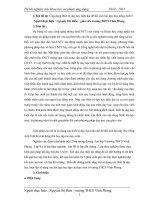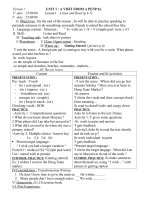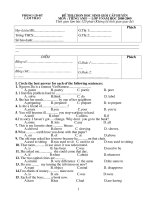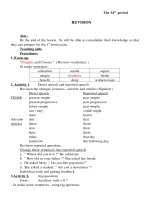tiếng anh 9 tuần 5
Bạn đang xem bản rút gọn của tài liệu. Xem và tải ngay bản đầy đủ của tài liệu tại đây (129.67 KB, 9 trang )
<span class='text_page_counter'>(1)</span><div class='page_container' data-page=1>
<b> Unit 2: Clothing</b>
<b>I.Trọng tâm kiến thức, kỹ năng:</b>
<b>1. Topic: </b>
<b>- Clothing</b>
<b>2. Competences:</b>
- Asking and responding to questions on personal preferences
- Asking for and giving information
<b>3.Skills:</b>
- Speaking: Ask and respond to questions on personal reference
- Listening: Listen to monologues / dialogues within 130-150 words for general or
detailed information
- Reading: Read passages within 150-180 words for general or detailed information
- Writing: Write an argument letter with a frame using suggested ideas or word
cues
<b>4. Grammar: </b>
- Present perfect: to talk about an action or a state which began in the past and
continues to the present.
<i>- The passive ( review ): be + past participle</i>
<b>5. Vocabulary </b>
- Words about clothing: types/ styles, colours, fashions, material, designs
<b>II. Unit plan:</b>
<b>Unit 2: Clothing (6 periods)</b>
Period 1 : Getting started- Listen and read
Period 2: Speak
</div>
<span class='text_page_counter'>(2)</span><div class='page_container' data-page=2>
Period 6: Language focus
<b>Date of preparing: 6/9/2019 Period 7</b>
Unit 2: Clothing
<b>Lesson 1: getting started- listen and read</b>
<b>A.Objectives:</b>
<b>1. Aims:</b>
- Introduce the topic of Unit 2 “Clothing”.
- Reading the text for details about “ Ao dai”- the traditional dress of
Vietnamese women.
- Vocabulary: traditional, pattern, unique.
- structure: The present perfect and the passive voice
<b>2. Practice skill: </b>
- practice the comprehension reading skill,writing and speaking skill.
<b>3. Attitude:</b>
- Help ss to have good consciousness in order to practice reading for detalis,
doing some exercises.
<b>B. Teaching- aids: </b>
Lesson plan, textbooks, pictures, poster.
<b>C. Methods:</b>
- Model-Talk-Practice, individual work, pair work
- Some techniques can be used: Matching, Pre question, Qts and answers,
Discussion
</div>
<span class='text_page_counter'>(3)</span><div class='page_container' data-page=3>
<i><b>I.Organization: ( 1m)</b></i>
<b>-</b> Greeting: Good morning!
<b>-</b> Who’s absent today?
<b>Class</b> <b>Date of teaching</b> <b>Absent ss</b>
9A 19/9/2019
<i><b>II. Warmer: (4’)</b></i>
<b>+Matching/ Getting started:</b>
? Open you books, look at the pictures & name the dresses that people are
wearing?
-T hang a poster with 2 columns & phrases then run through
- Divide class into 2 teams, model & ask ss to match the clothes they wear with the
countries they come from
-T get feedback from ss
A B
a. a kimono 1. He comes from the USA
b. Ao dai 2. He comes from Scotland ( UK )
c. a kilt 3. She comes from India
d. a sari 4. She comes from Vietnam
e. jeans 5. She comes from Arabia (Saudi )
f. a veil 6. She comes from Japan
n.b:- a kilt ( n ) váy người miền núi Keys: a-6, b-4, c-2, d-3, e-1, f-5
- a sari ( n ) vải quấn quanh thay cho quần áo
- a veil ( n ) màng che mặt
<i><b>III.New lesson</b></i>
<b>Step 1: Pre-reading ( 10’ )</b>
</div>
<span class='text_page_counter'>(4)</span><div class='page_container' data-page=4>
Eg: Nguyen Du, To Huu are….
Translation
Translation
Translation
Eg: Ede,H’mong, Thai are…
Picture
-T follow steps of teaching vocab
ss study words step by step
+Rub out & remember
-T follow steps of ROR
+Pre-questions
-T: You are reading a text about Ao
dai-the traditional dress of Vietnam.
T gives 2 qts, ask ss to answer without
reading the text
<b>Step 2: While-reading ( 16’ )</b>
+Activity 1
-Ss listen to the tape & read the text to
answer the pre-qts
-T get feedback from ss
+Activity 2: Gap-fill
? Look at exer a P.14
-T run through, and model. Ss read the
text again to get information to
complete the sentences individually
compare with partners
-T get feedback from ss
- poet ( n ) nhà thơ
- long silk tunic ( n ) áỏo lụa dài rộng
- slit ( v ) xẻ ( n: đờng xẻ )
- inspiration ( n ) cảm hứng, hứng khởi
- ethnic minority ( n ) dân tộc thiểu số
- pattern ( n ) hoa văn, mẫu vẽ
<b>II.Reading</b>
<i><b>1.Pre questions:</b></i>
a.What material is Ao dai made from?
( silk )
b.Who wears Ao dai? Is modern Ao dai
different from the old one?
( Women, it is different….)
<i><b>2.Exercise a P.14</b></i>
1….poems, novels, and songs.
2…..long silk tunic with slits up the side
worn over loose pants
3….to wear modern clothing at work
4…..lines of poetry on it
</div>
<span class='text_page_counter'>(5)</span><div class='page_container' data-page=5>
+Activity 3: Comprehension questions
? Look at exer b P.14
-T run through the 3 qts. Ss read the text
again and answer the qts in pairs
pairs compare
-T get feedback from ss ( ask some
pairs to ask & answer before class )
<b>Step 3: Post-reading ( 10’ )</b>
+Discussion
-T divide class into groups of 8- each
group has a secretary
-T give a topic, ask ss to discuss in
groups
- Representative from a group speak
before class, other groups add more
-T add if necessary
crosses, and stripes
<i><b>3.Exercise b P.14</b></i>
1. Traditionally, men and women
used to wear the “ Ao dai”
2. Because it is more convenient
3. They have printed lines of poetry
on it or have added symbols such
as suns, stars, crosses, and stripes
to the “ Ao dai”
<b>III.Speaking.</b>
+Topic: Tell what you have known
about the “ Ao dai” ?
<i><b>IV. Summary ( 1’ )</b></i>
? What do we learn today? Do you like Vietnamese Ao dai? Why/ Why not?
<i><b>V. Homework ( 3’ )</b></i>
- Write a short paragraph telling what you have known about the “ Ao dai”.
- Prepare the “Speak” for the next lesson.
<b>*Evaluation:</b>
</div>
<span class='text_page_counter'>(6)</span><div class='page_container' data-page=6>
...
...
<b>Date of preparing: 9/ 9/ 2019 Period 8</b>
Unit 2: Clothing
<b> Lesson 2: speak </b>
<b>A.Objectives:</b>
<b>1. Aims:</b>
<b> - Know more words about clothes and practice in asking & answering about the </b>
dress/ clothes.
<b>+ Standard knowledge: Ask and respond to questions on personal references.</b>
<b>+ Advanced knowledge: Interview their friends about the suitable clothes in each </b>
occasion.
<b>+ Basic language:</b>
Vocab: T-shirt, suit, skirt, school uniform, casual, formal, short-sleeved,
striped, faded, plain.
The tense: simple present tense.
<b>2. Practice skill: </b>
- Practice speaking skill and writing skill.
<b>3. Attitude:</b>
- Help ss to have good consciousness in order to practice speaking , making
some similar dialogues.
<b>B. Teaching- aids: </b>
Lesson plan, textbooks, pictures, poster.
</div>
<span class='text_page_counter'>(7)</span><div class='page_container' data-page=7>
- Model-Talk-Practice, individual work, pair work
- Some techniques can be used: Network, retelling, survey, slap the board
<b>D. Procedure:</b>
<b>I.Organization: ( 1’)</b>
<b>-</b> Greeting: Good morning!
<b>-</b> Who’s absent today?
<b>Class</b> <b>Date of teaching</b> <b>Absent ss</b>
9A 21/9/2019
<i><b> II. Warmer: ( 4’ )</b></i>
+Network
-T model, ss tell names of clothes they know T. shirt
- Ss write on bb in 2 groups
-T get feedback & add more if necessary
<i><b>III.New lesson</b></i>
<b>Step 1: Pre-speaking ( 10’ )</b>
+Preteach
Picture
Picture
Realia
Realia/ picture
Realia
T follow steps of teaching
vocab
+Slap the board
T follow steps of slapping the
<b>I.Vocabulary</b>
- plaid ( adj ) kẻ ca rô, kẻ ô vuông
- plain ( adj ) trơn ( khơng có hoa văn)
- faded ( adj ) bạc màu, phai màu
- baggy ( adj ) rộng thùng thình
Eg: baggy pants: quần ống thụng
- short-sleeved/ sleeveless ( adj ) ng¾n tay/
Khơng có tay ( sát nách )
clothes
Ng¾n tay
</div>
<span class='text_page_counter'>(8)</span><div class='page_container' data-page=8>
board
+Matching
? Look at exer a P.14
-T run through & model, ss
match the phrases to the
pictures in pairs compare
with the partners
-T get feedback from ss
<b>Step 2: While-speaking </b>
<b>(18’ )</b>
+Activity 1: Survey
-T give handouts & model
with a ss, ask ss to work in
pairs asking & answering then
tick ( v ). Ss work in open
then close pairs.
<b>Eg:</b>
S1:What do you usually wear
on weekday?
S2: I often wear school
uniform
S1: Why do you wear these
clothes?
S2: Because ..……….
S1:Which clothes do you like
wearing on Tet holiday/ at a
<b>II.Speaking</b>
<i><b>1.Exercise a P.14</b></i>
a-1, b-5, c-6, d-3, e-8, f-4, g-7, h-2, i-9
<i><b>2.Exercise b P.15</b></i>
Occasion
Clothes
Week-day weekend Special
occasion
1.casual
clothes
2.favorite
clothes
3.school
uniform
v.
compulsory
v.
comfortable
v. more
confident
</div>
<span class='text_page_counter'>(9)</span><div class='page_container' data-page=9>
party….?
S2:…..
-T. go round to help &
monitor
<b>Step 3: Post-speaking ( 9’ )</b>
+Retelling
-Ss retell their survey before
class using indirected speech
-T get feedback from ss &
correct if necessary.
<i><b>3.Exercise c P.16</b></i>
Eg: Lan said that she liked wearing favorite
clothes on special occasion because she felt more
confident…..
<i><b> IV. Summary ( 1’ )</b></i>
? What do we learn today? ( Names of some clothes……)
<i><b> V. Homework ( 2’ )</b></i>
- Write a short paragraph about types of clothes you like.
- Prepare “Listen” for the next lesson.
<b>*Evaluation</b>
………
….
………
….
</div>
<!--links-->









